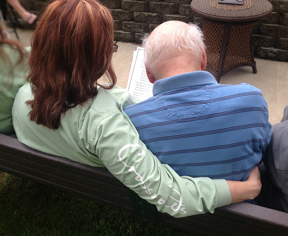 This weekend, I was at my local mall and was saddened — and admittedly a bit angered — by an incident I witnessed. While In the food court I noticed an elderly lady, I am guessing in her 80s, using her cane and making her way with her food over to the only empty table. Suddenly, a group of teenage girls ran over to the empty table, slammed their trays on the table, looked up at bewildered woman and laughed. I quickly redirected the sweet little lady over to my table while helping her with her tray, trying to apologize for the girls.
This weekend, I was at my local mall and was saddened — and admittedly a bit angered — by an incident I witnessed. While In the food court I noticed an elderly lady, I am guessing in her 80s, using her cane and making her way with her food over to the only empty table. Suddenly, a group of teenage girls ran over to the empty table, slammed their trays on the table, looked up at bewildered woman and laughed. I quickly redirected the sweet little lady over to my table while helping her with her tray, trying to apologize for the girls.
This got me to thinking about elder abuse. Obviously, being rude is one thing, but elder abuse is another. I’m sure that these young girls are not elder abusers, just typical, smart mouth, peer-pressured teens. Although the line may be thin between being rude and actual abuse, recognizing elder abuse is paramount to ensure that we are protecting our seniors.
On June 15, World Elder Abuse Prevention Day brings attention to the underreported problem of elder abuse, and how we as a society can prevent it or stop it from happening.
The Centers for Disease Control (CDC) estimates that in the United States alone, over 500,000 older adults are abused or neglected each year. But, it’s also assumed that incidents are underreported because the abuser is usually a caregiver — a spouse, adult child or family member — and the victim may not want to report it out of fear of further abuse.
Anyone who sees, hears or interacts with elders has the power to speak for the ones who are victims; to make sure their voices are heard in a time of need. Being able to identify elder abuse is the first step to being a part of the unofficial community of people who are compassionate towards elders and committed to reducing the statistics. Although abuse comes in many forms, there are three types that everyone should know the signs of:
1. Physical abuse — This is the most recognizable type of abuse. Typical signs include bruises, especially in clusters or regular patterns; blackened eyes; burns caused by hot objects; or rubbed skin from restraints.
2. Emotional abuse — This may be harder to identify than physical abuse, but there are signs that elders may demonstrate to indicate they’re being emotionally abused. Look out for signs like unexplained or uncharacteristic changes in the elder’s personality; the abuser (typically a caregiver) attempting to isolate the elder by not allowing others to speak with the elder without the caregiver’s presence; and the abuser being verbally controlling, personally demeaning or aggressive to the elder.
3. Financial abuse — Unfortunately, financial abuse is becoming more prevalent. Signs include the lack of basics in the elder’s home, such as food and toiletries; or that the abuser may have control of the elder’s money, but is obviously not using it for the elder’s personal needs. Another big sign is if the elder transfers property or financial resources into the abuser’s name but is incompetent to make other significant decisions.
Elder abuse can happen to anyone, anywhere. This isn’t a problem that is unique to a specific race or economic class. However, some groups are statistically more likely to be victims of elder abuse, including women, elders who are homebound and elders over the age of 80.
Reporting abuse, even suspected abuse, is critical to ensure that our elders are protected. If abuse is even remotely suspected, you should contact the local authorities or adult protective services. It’s better to be wrong than sorry.
To report elder abuse, call the state elder abuse hotline. For a full list of state hotlines, go to the National Council on Child Abuse and Family Violence hotline page.
 DeAnna L. Looper RN, CHPN, CHPCA
DeAnna L. Looper RN, CHPN, CHPCA
Chief Corporate Clinical Consultant / Legal Nurse Consultant / HPNA Approved Educator/Certified ELNEC Trainer/ Certified Grief Recovery Specialist
